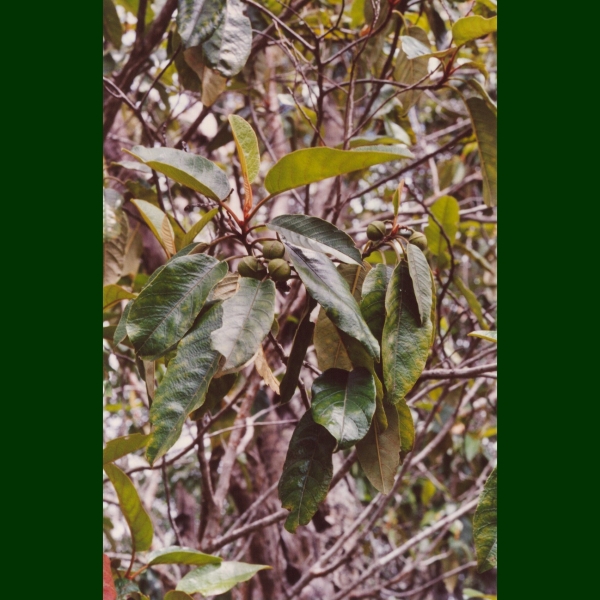 Hawaiian Name(s): kauila, kauwila, o‘a (Maui)
Hawaiian Name(s): kauila, kauwila, o‘a (Maui)Scientific Name: Alphitonia ponderosa
Vernacular Name: none
Family: Rhamnaceae
Status: endemic
Authority: Hillebr.
Description: Trees, 4–25 m tall, wood is very hard.
Habitat Found in dry to mesic forests on most main islands (most common on Kaua‘i) between 240–1250 m (Wagner et al.1990:1092–1093).
Medicines: The treatment for na ma‘i‘e‘eu o ka ‘ili, kuhewa, and maka‘u ano ‘e no (shudders, fears). Shavings from the trunk of the kauila tree are mixed with water and taken internally (Chun 1994:140).
Non Medicinal Uses: There are two trees from the Rhamnaceae family that are both called kauila (Alphitonia ponderosa and Colubrina oppositifolia). In the ethnographic literature and the Bishop Museum ethnology collection it is usually unclear which of the two is actually represented. Therefore it is not certain which of the species may actually be represented in some of the information and images that follow. Kauila wood was used for many purposes, including as house beams; kapa beaters (i‘e kuku and hohoa) (Krauss 1993:61,63,69); fishing spears (kao or ‘o) and netting needle or shuttle (hi‘a ka ‘upena) (Krauss 1993:34,35,45), javelins (darts, ihe pahe‘e or pahe‘e) & spears (long spear or pololu); daggers (pahoa); clubs & shark-tooth clubs (Krauss 1993:94–97, 106–111); ‘o‘o (digging stick) (Krauss 1993:25); guessing games pieces (polished sticks hidden in hands), heavy base used in "wand game" (‘ume or pili) (Krauss 1993:92–93); ‘ukeke (musical bow); it was the preferred wood to repair wooden bowls (small pegs hammered in) (Krauss 1993:80, 85). In the Ethnology Collection at Bishop Museum there is a post-contact example of the wood made into a bowl and one of Kamehameka I's spears is said to have been reworked into this cane. Additional collections items of kauila are pestles and an amulet.
Specific gravity of wood: unknown
Famous Locations:
Mele:
`Ōlelo Noeau:
Dye Color and Parts: Bluish (leaves & bark)
Kino lau:
Location on Bishop Museum Kalihi Campus:
Propagation Information: Intermediate. Grow from seeds, transfer sprouts to individual pots of 1:1 small cinder:vermiculite when roots appear, keep well watered, sulfur in mix will protect against diseases (Culliney and Koebele 1999:70–72).
Hawaiian Native Plant Propagation Database.
Native Plants Hawaii.
Seed: Seed length approximately 7 mm. Photograph: H.Lennstrom.

Microscopy
Cross Section: Field of view: 2.6 mm x 1.6 mm. Photograph: H.Lennstrom.

Radial Section: Field of view: 2.6 mm x 1.6 mm. Photograph: H.Lennstrom.

Tangential Section: Field of view: 2.6 mm x 1.6 mm. Photograph: H.Lennstrom.

